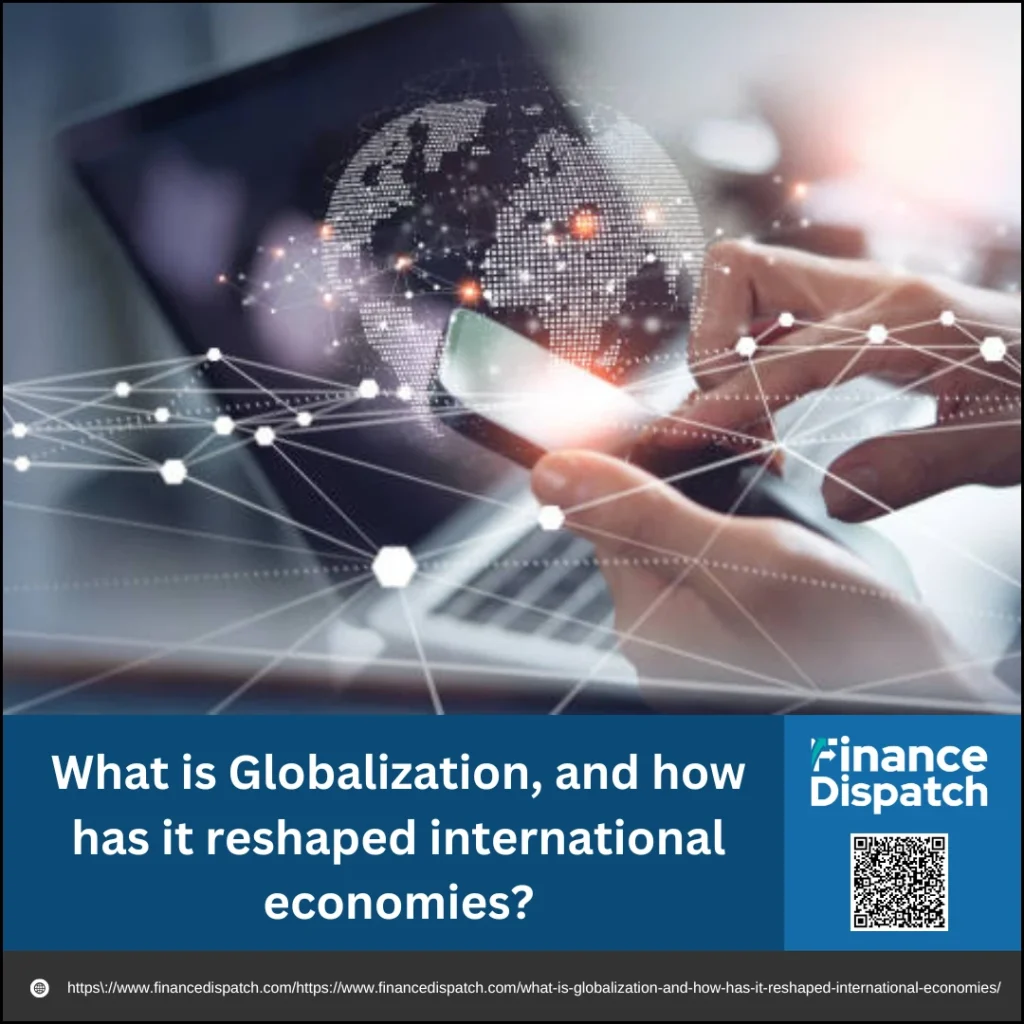Globalization is the process through which countries, businesses, and societies become increasingly interconnected and interdependent through the exchange of goods, services, information, technology, and capital. Driven by advancements in transportation and communication, as well as liberalized trade and investment policies, globalization has transformed how economies operate on both national and international levels. It has redefined market boundaries, accelerated the flow of resources, and integrated financial systems across the globe. As this multifaceted phenomenon continues to evolve, it has significantly reshaped international economies—boosting growth in some regions while presenting challenges in others.
What is Globalization?
Globalization refers to the growing interconnectedness and interdependence of countries through the widespread exchange of goods, services, ideas, technology, capital, and people. It is driven by advancements in communication and transportation technologies, the expansion of global trade, and the liberalization of economic policies. In economic terms, globalization allows businesses to operate on an international scale, access new markets, and source labor and resources from around the world. It enables countries to specialize in their comparative advantages, leading to more efficient production and greater global integration. As a result, globalization not only connects economies but also influences political, cultural, and social systems across borders.
Historical Context of Globalization
The roots of globalization stretch back thousands of years, beginning with ancient trade networks like the Silk Road, which connected merchants and cultures across Asia, the Middle East, and Europe. These early exchanges laid the foundation for cross-border trade, cultural diffusion, and economic interdependence. The Age of Exploration in the 15th and 16th centuries expanded these connections, as European powers established global maritime trade routes. The Industrial Revolution marked a turning point by accelerating production, transportation, and communication, enabling nations to engage more deeply in international commerce. In the post-World War II era, the formation of institutions such as the United Nations, International Monetary Fund, and World Trade Organization established frameworks for global economic cooperation. Today’s globalization, intensified by digital technology and the internet, represents the latest phase in this long evolution of global integration.
Key Drivers of Globalization
Globalization has accelerated rapidly in recent decades due to a combination of technological, economic, political, and social forces. These drivers have not only reduced barriers to cross-border interactions but also enhanced the speed, scale, and complexity of global integration. Understanding these key factors helps explain how globalization continues to reshape international economies.
1. Technological Advancements: Innovations in transportation, communication, and digital infrastructure have made it easier to move goods, services, and information across borders.
2. Trade Liberalization: The removal of tariffs, quotas, and other trade barriers has enabled a freer flow of goods and services between nations.
3. Growth of Multinational Corporations: Large companies operating in multiple countries facilitate investment, job creation, and the global movement of products and capital.
4. Expansion of Financial Markets: Integrated financial systems allow for easier cross-border investment, currency exchange, and capital flow.
5. Cultural and Social Exchange: Increased global travel, media, and digital communication promote the spread of ideas, lifestyles, and consumer culture.
6. International Institutions and Agreements: Organizations such as the WTO, IMF, and regional trade blocs help regulate and promote global trade and economic cooperation.
Core Components of Globalization
Globalization is a complex and multifaceted process shaped by various interlinked components. These core elements span across economic, political, cultural, technological, and environmental dimensions. Together, they drive the interconnectedness of nations and explain how globalization impacts diverse aspects of society and international relations.
| Component | Description |
| Economic | Involves global trade, foreign direct investment, integrated markets, and multinational business operations. |
| Political | Refers to international cooperation, treaties, and governance through organizations like the UN and WTO. |
| Cultural | Encompasses the global spread of languages, media, customs, and values, leading to cultural exchange or homogenization. |
| Technological | Driven by innovations in transport, communication, and information systems that enable global connectivity. |
| Environmental | Addresses shared global issues such as climate change, sustainability, and resource management across nations. |
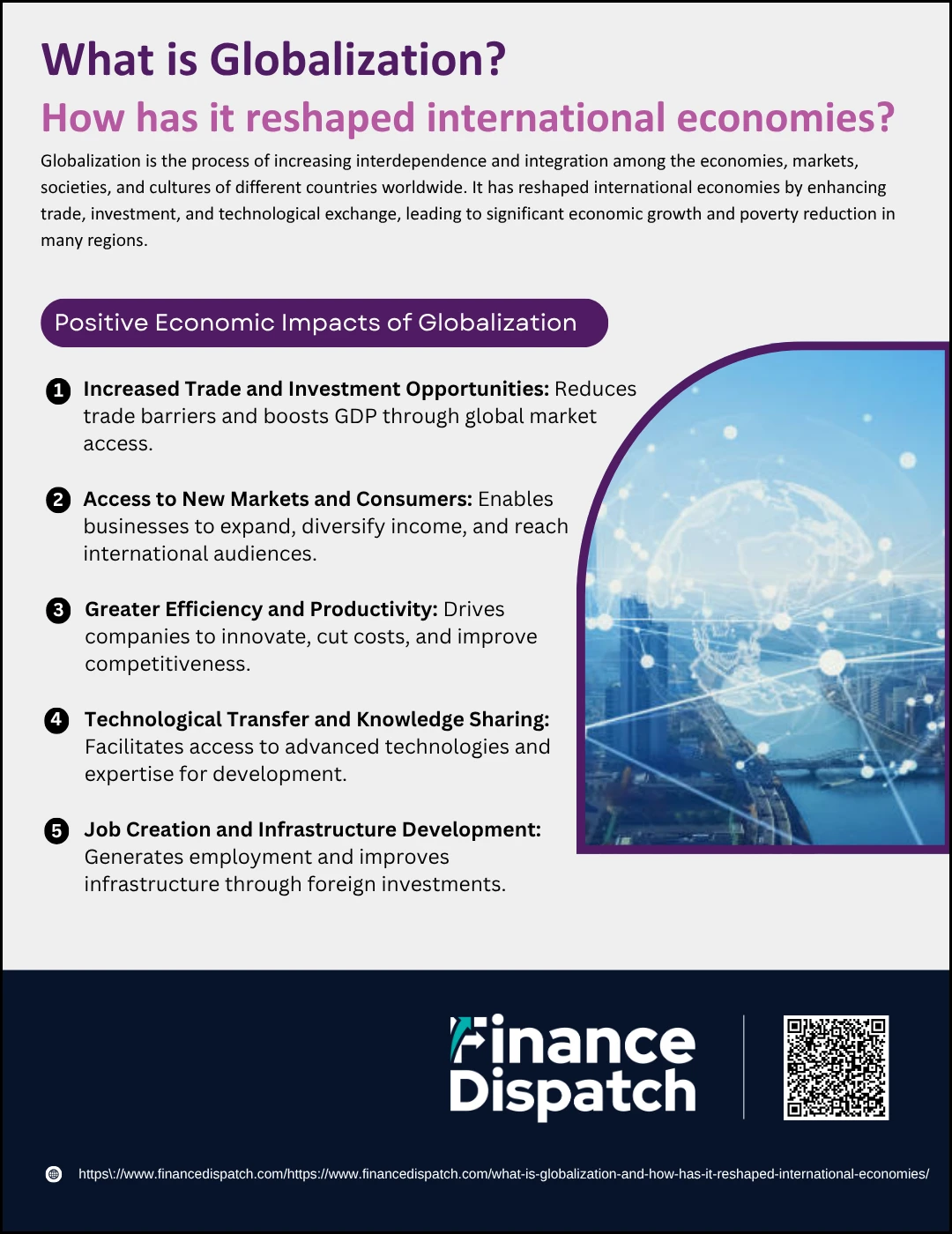 Positive Economic Impacts of Globalization
Positive Economic Impacts of Globalization
Globalization has significantly transformed the global economic landscape by enabling deeper integration of national economies. Through the expansion of international trade, investment, and technology transfer, it has contributed to stronger economic performance and improved standards of living in many regions. While the benefits are not always equally distributed, the positive economic impacts are both diverse and far-reaching, offering opportunities for growth, innovation, and development on a global scale.
1. Increased Trade and Investment Opportunities
Globalization reduces trade barriers and encourages foreign direct investment (FDI), allowing countries to access global markets. This leads to higher levels of exports, imports, and investment flows that boost GDP and foster international economic collaboration.
2. Access to New Markets and Consumers
Businesses can grow beyond local demand by entering international markets. This global outreach allows firms to scale up operations, diversify revenue sources, and adapt products to different cultural and economic environments, enhancing profitability and growth potential.
3. Greater Efficiency and Productivity
With exposure to international competition, businesses are driven to improve efficiency, reduce costs, and adopt innovative practices. This results in higher productivity, better use of resources, and more competitive industries.
4. Technological Transfer and Knowledge Sharing
Through partnerships, joint ventures, and global networks, developing countries can acquire advanced technologies and expertise from more industrialized nations. This accelerates innovation, improves manufacturing capabilities, and supports sustainable development.
5. Job Creation and Infrastructure Development
Global investment in industries like manufacturing, technology, and services often creates employment opportunities. At the same time, globalization encourages improvements in infrastructure such as roads, ports, and digital connectivity, which further facilitate economic development.
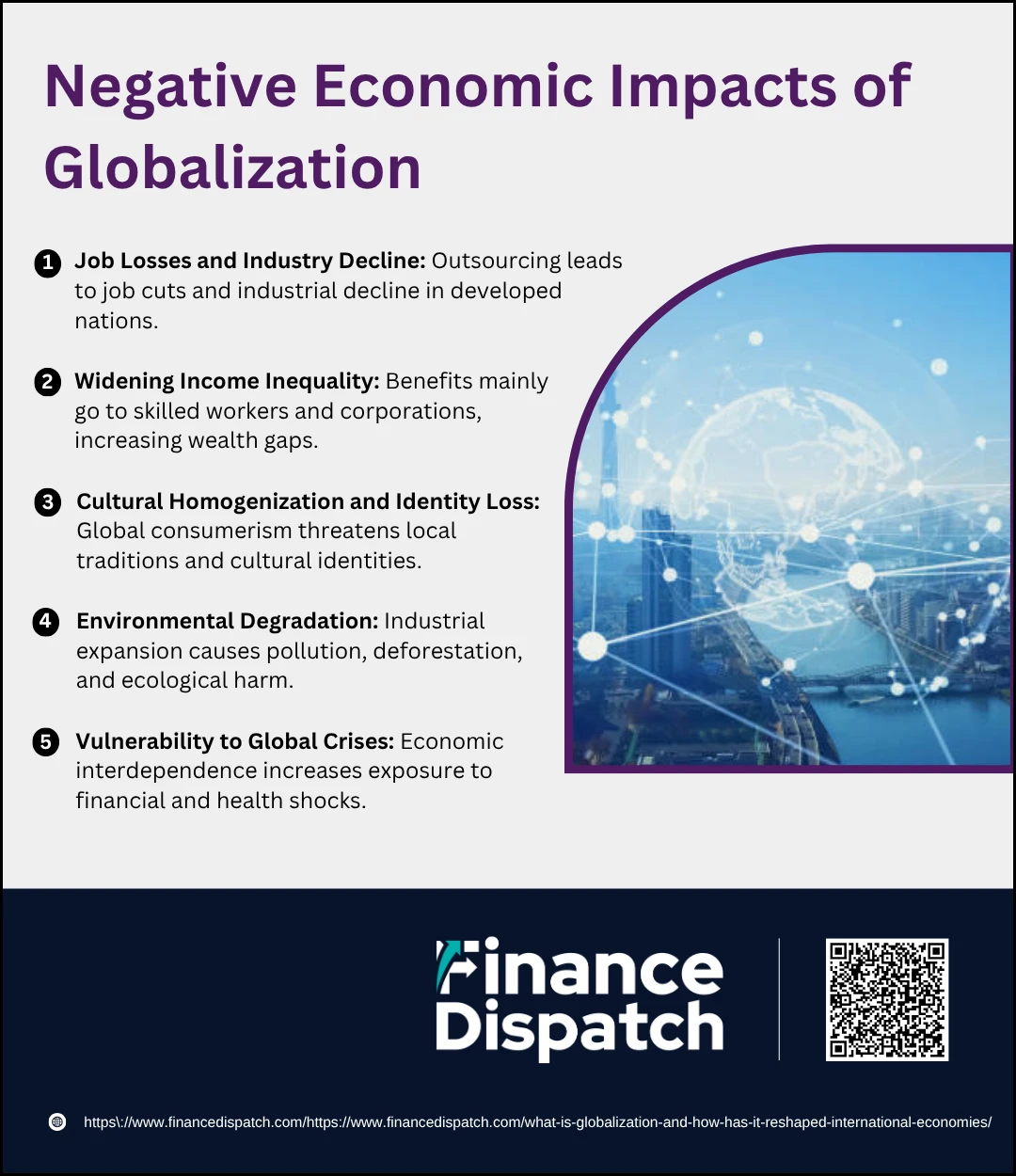 Negative Economic Impacts of Globalization
Negative Economic Impacts of Globalization
Despite the economic growth and innovation driven by globalization, it has also brought serious drawbacks that affect both developed and developing countries. These challenges often arise from unequal access to the benefits of globalization, deregulated markets, and intensified global competition. While some nations and businesses flourish, others experience setbacks that include job displacement, environmental damage, and economic vulnerability. Understanding these negative impacts is essential to developing more inclusive and sustainable globalization strategies.
1. Job Losses and Industry Decline
One of the most visible downsides of globalization is the relocation of industries to countries with cheaper labor. This outsourcing often results in significant job losses in developed nations, particularly in manufacturing and low-skilled sectors. Communities that once depended on stable factory employment can experience long-term economic decline and social instability.
2. Widening Income Inequality
Globalization tends to benefit high-skilled workers, investors, and multinational corporations far more than low-skilled labor. This unequal distribution of wealth increases the income gap between and within countries. In developing regions, foreign investments often flow to a few urban centers, leaving rural populations marginalized.
3. Cultural Homogenization and Identity Loss
The spread of global consumer culture, especially through media and multinational corporations, can erode local traditions, languages, and cultural identities. As Western lifestyles and values become dominant, cultural uniqueness is often replaced by standardized global norms, weakening community cohesion and national heritage.
4. Environmental Degradation
The demand for mass production, natural resources, and global logistics under globalization has intensified environmental harm. Deforestation, air and water pollution, and greenhouse gas emissions are byproducts of industrial expansion and international trade. In some cases, companies exploit weak environmental regulations in developing countries, worsening ecological damage.
5. Vulnerability to Global Crises
Economic interdependence makes countries more exposed to global financial shocks, pandemics, or political conflicts. For instance, a financial crisis in one country can ripple through international markets, affecting jobs, investments, and currencies worldwide. Similarly, disruptions in global supply chains—such as those seen during the COVID-19 pandemic—reveal how fragile interconnected economies can be.
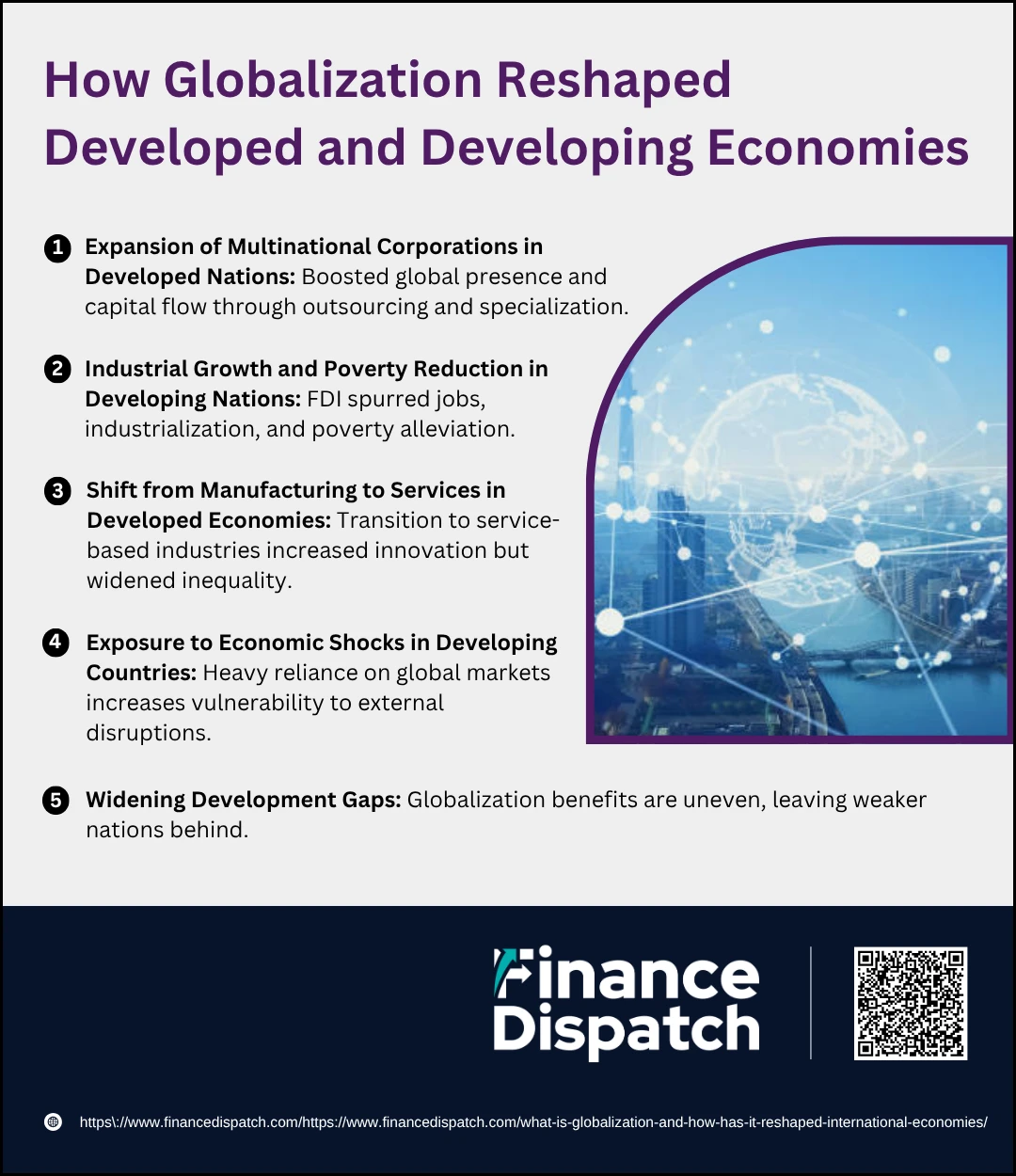 How Globalization Reshaped Developed and Developing Economies
How Globalization Reshaped Developed and Developing Economies
Globalization has restructured economies across the world, but its influence has played out differently for developed and developing nations. For wealthier countries, globalization has opened avenues to outsource production, expand multinational reach, and dominate global financial markets. Meanwhile, many developing countries have benefited from increased trade, foreign investment, and industrial growth—but these gains often come with heightened exposure to external shocks and social challenges. This dual impact underscores the complexity of globalization and the varying capacities of nations to harness its benefits.
1. Expansion of Multinational Corporations in Developed Nations
Developed economies like the United States, Germany, and Japan have capitalized on globalization by growing multinational enterprises. These firms often outsource manufacturing to low-cost regions while maintaining control of high-value activities such as research, branding, and finance. This has strengthened their global market presence and increased capital flows back to the home countries.
2. Industrial Growth and Poverty Reduction in Developing Nations
Countries such as China, India, and Vietnam have attracted foreign direct investment (FDI), resulting in rapid industrialization and export-driven growth. This has created millions of jobs and lifted large segments of the population out of poverty. Improved infrastructure, higher productivity, and rising living standards are some of the key transformations linked to globalization in these regions.
3. Shift from Manufacturing to Services in Developed Economies
As labor-intensive industries migrated to developing countries, many developed nations transitioned to service-based economies. Sectors such as finance, healthcare, technology, and education became the new engines of growth. While this shift boosted innovation and incomes for skilled workers, it also widened income gaps and reduced employment opportunities for low-skilled labor.
4. Exposure to Economic Shocks in Developing Countries
The increasing reliance on exports and foreign capital has made many developing economies highly susceptible to external disruptions. Global financial crises, commodity price crashes, or supply chain disruptions can have swift and severe effects, undermining growth and causing social unrest in countries lacking strong economic buffers.
5. Widening Development Gaps
Although globalization has provided opportunities for some developing countries to thrive, others—particularly those with weak institutions, limited infrastructure, or unstable governance—struggle to participate meaningfully. This creates uneven development patterns, where some regions experience modernization and prosperity while others remain marginalized and heavily dependent on external support.
Strategies to Adapt and Succeed in a Global Economy
To thrive in an increasingly interconnected world, governments, businesses, and workers must adopt strategic approaches that respond to the challenges and opportunities of globalization. Success in the global economy requires adaptability, investment in human capital, and sustainable growth policies. These strategies help nations and organizations remain competitive, resilient, and inclusive amid rapid global change.
1. Invest in Education and Skills Development: Strengthening the workforce through vocational training, STEM education, and lifelong learning programs ensures that workers are equipped for evolving global job markets.
2. Diversify the Economy: Relying on a single industry makes economies vulnerable. Diversifying sectors—such as combining agriculture, technology, and manufacturing—builds resilience against global shocks.
3. Build Modern Infrastructure: Investment in transportation, digital networks, and energy systems enhances trade efficiency, attracts foreign investment, and connects local markets to global supply chains.
4. Support Small and Medium-Sized Enterprises (SMEs): Offering access to financing, training, and export opportunities empowers SMEs to compete globally and drive innovation from the grassroots level.
5. Adopt Sustainable and Inclusive Policies: Environmental regulations, labor protections, and inclusive economic policies ensure that globalization’s gains are broad-based and long-lasting.
6. Encourage Foreign Direct Investment (FDI): Creating stable legal environments, offering tax incentives, and simplifying business regulations can attract global investors and stimulate domestic growth.
7. Foster International Partnerships and Networks: Collaborating with other countries and institutions allows for knowledge sharing, technological exchange, and joint ventures that benefit all stakeholders.
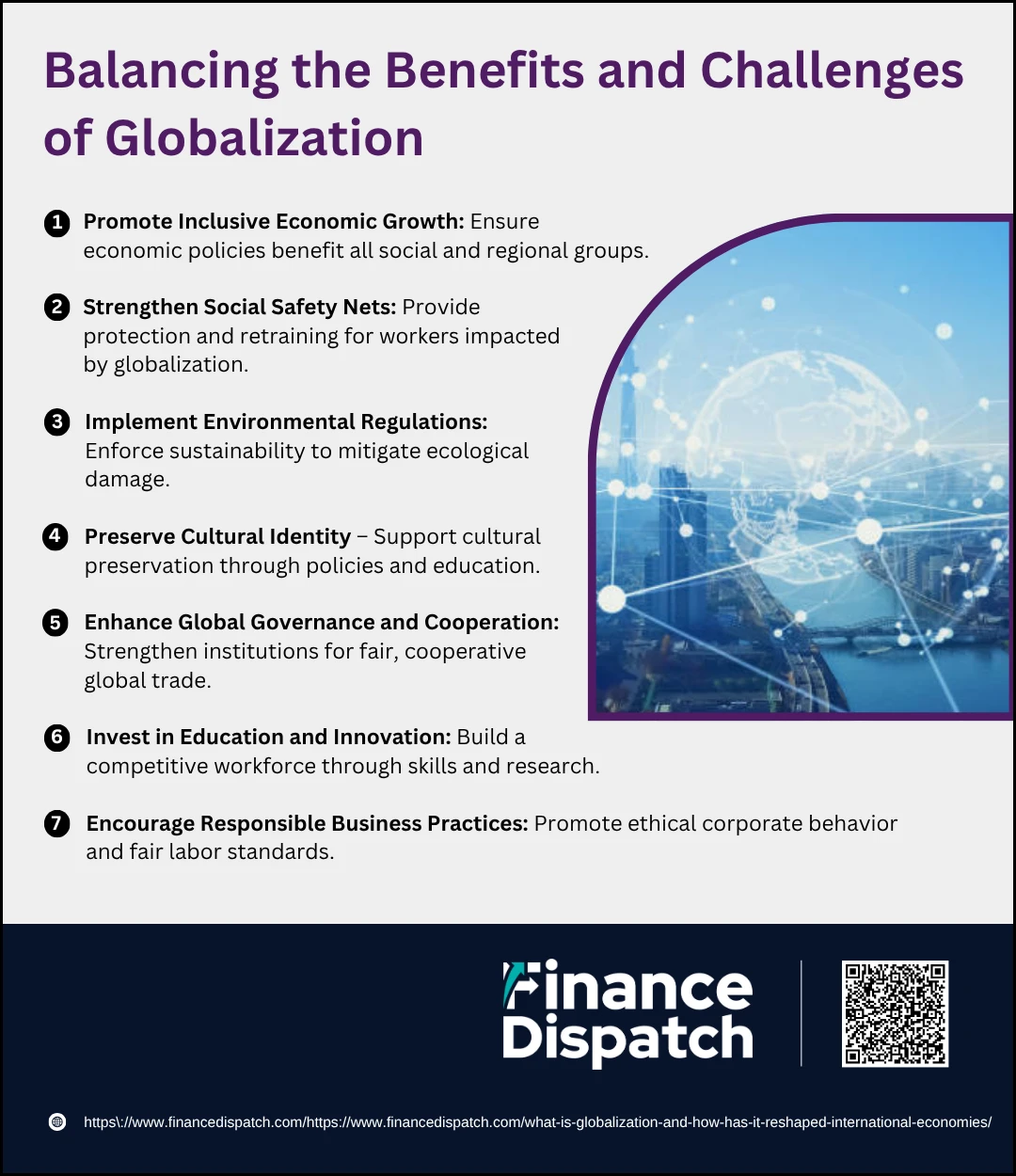 Balancing the Benefits and Challenges of Globalization
Balancing the Benefits and Challenges of Globalization
Globalization has transformed the global economy, offering countries unprecedented access to markets, technologies, and opportunities. However, it has also contributed to widening income gaps, job displacement, environmental harm, and cultural homogenization. To harness the benefits while minimizing the downsides, a balanced and inclusive approach is essential. This involves targeted policies and international cooperation that ensure fair distribution of economic gains, protect vulnerable populations, and promote sustainability and cultural diversity. A proactive, strategic balance can help nations thrive in a globalized world while safeguarding their social and environmental integrity.
1. Promote Inclusive Economic Growth
Governments should implement economic policies that ensure prosperity reaches all segments of society. This includes supporting underserved communities, rural areas, and disadvantaged groups through equitable access to capital, infrastructure, and opportunities.
2. Strengthen Social Safety Nets
As globalization can lead to job losses in certain sectors, nations must provide robust social protection systems. These include unemployment insurance, healthcare, pensions, and job retraining programs to support affected workers and reduce social unrest.
3. Implement Environmental Regulations
To address the environmental costs of industrialization and trade, countries should enforce strict pollution controls, promote renewable energy, and encourage sustainable business practices to protect ecosystems and combat climate change.
4. Preserve Cultural Identity
While embracing global exchange, nations must protect their unique languages, traditions, and arts. Policies that promote local media, education in native languages, and cultural festivals can strengthen national identity in a globalized environment.
5. Enhance Global Governance and Cooperation
Effective global governance ensures that trade and investment rules are fair, transparent, and beneficial to all. Institutions like the United Nations and World Trade Organization must be strengthened to handle global issues collaboratively and equitably.
6. Invest in Education and Innovation
Long-term success in a global economy depends on building a skilled, adaptable workforce. Governments and businesses should invest in quality education, research, digital literacy, and innovation hubs to remain competitive and resilient.
7. Encourage Responsible Business Practices
Corporations must uphold high ethical standards by paying fair wages, avoiding exploitative practices, and respecting labor rights. Governments can incentivize such behavior through certifications, regulations, and consumer awareness campaigns.
Conclusion
Globalization has become a defining force in the modern world, reshaping how nations interact, how businesses operate, and how people live and work. It has opened new avenues for economic growth, cultural exchange, and technological advancement, while also introducing challenges such as inequality, environmental stress, and cultural erosion. The key to sustaining the benefits of globalization lies in creating policies and strategies that promote inclusive growth, protect vulnerable communities, and ensure long-term environmental and social sustainability. By thoughtfully balancing opportunity and risk, countries can harness globalization to build more resilient, equitable, and prosperous economies for future generations.



